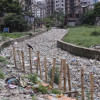No need for water bodies!

That was basically the message realtors had given Rajuk in early November in a views-sharing meeting. Realtors believe it is ludicrous for Rajuk to try and reclaim what has already been grabbed. Indeed, that meeting could easily be termed a circus, since it was said that Dhaka would be better off without its wetlands since it was pointed out by a representative that the only purpose of water bodies is to serve the mosquito population. Never mind the experts' opinions and feasibility studies that wetlands are mandatory for the city's natural drainage system. Never mind the fact that the city, which was once defined by its aqua lands, has lost around 2,500 acres of flood flow zones and agricultural lands.
Rajuk remains silent against this relentless drive by the high-and-mighty coterie of wetland grabbers and presently we are witnessing the demise of the Dumni canal on the city's eastern outskirts. The canal is in the final throes of being filled up and going by what has been printed in The Daily Star on December 24, a 120-foot-wide canal is now 10-foot-wide. "Half a dozen land claimants—three real estate developers, two private land claimants and a government organisation—have so far either blocked and filled up parts of the canal or narrowed it down to one-twelfth of its official width since 2009,"s aid locals.
So this has been going on since 2009. But then, protests have been falling on deaf ears of the authorities. In the midst of all this, we have a chief engineer of Rajuk going on record to state that the building of a culvert which narrows the canal's width to 10 feet is "not a problem, water will flow anyway. Width of a canal is to be reduced if a structure is built over it." This is in contradiction to the 2006 study by British Halcrow Group on flood management that recommended widening and conserving existing canals along with storm water retention ponds and areas as flood management measures.
When we look at the history of filling up of water bodies, and that includes rivers like the Turag, one finds a pattern that is followed by realtors. They seldom act alone. Countless reports have emerged in media about how adept they are at skirting the legal system and "managing" enough leverage among both the custodians of water bodies and enforcers of the law to effectively kill canals and rivers.
Last year, this paper ran a story on the Turag River which outlined the systematic destruction of Turag starting from the year 2009. Once a mighty river, touted as one of the key rivers that supplies water to the city, has been witness to relentless encroachment by land grabbers who have filled up major chunks of the river and turned them into theme parks, housing estates, industries, etc.
What we have lost in the process is supply of freshwater for human consumption and agriculture, fish resources, marine ecology and waterfront. Land grabbing has flourished unabated without giving two hoots to a 2009 landmark High Court judgment that had delineated detailed measures on how ailing rivers may be recovered on five rivers feeding Dhaka , viz. Buriganga, Balu, Turag, Sitalakkhya and Dhaleshwari.
While the mighty Turag has fallen prey to land grabbers in a big way, we have managed to kill the Sitalakkhya with the dumping of untreated toxic industrial discharge. The water of the Sitalakkhya is as black as that of Buriganga, which until very recently was home to the leather industry at Hazaribagh. Going by recent news, we understand that not all factories have relocated to the new leather estate in Savar and the dumping of toxic material continues there. While a major chunk of tanneries have moved, there are other factories in the vicinity that follow the same custom of discharging untreated chemical waste into the river. Amid much fanfare, the tanneries were moved to the leather estate. There too problems persist. Land had been allocated, but the problems associated with who would bear what portion of cost of the central effluent plant (CETP) were allowed to fester whilst many units went into production. So, while Buriganga may see a revival of sorts somewhere down the years, it appears that the Dhaleshwari is now going downhill.
It does not matter which river or canal we highlight in media, the bottom line is that we have a DAP that is not followed by authorities. We have various agencies which have proven themselves to be utterly inept, toothless and powerless in the face of land-grabbing companies which are backed by serious political clout. We have seen that public outrage and outcry mean little to anyone in office and that laws are there to adorn the books but not be implemented. We live in a system that is built around powerful vested interests where profit is king and where the environment and people's collective voice do not count.
Syed Mansur Hashim is Assistant Editor, The Daily Star.









Comments